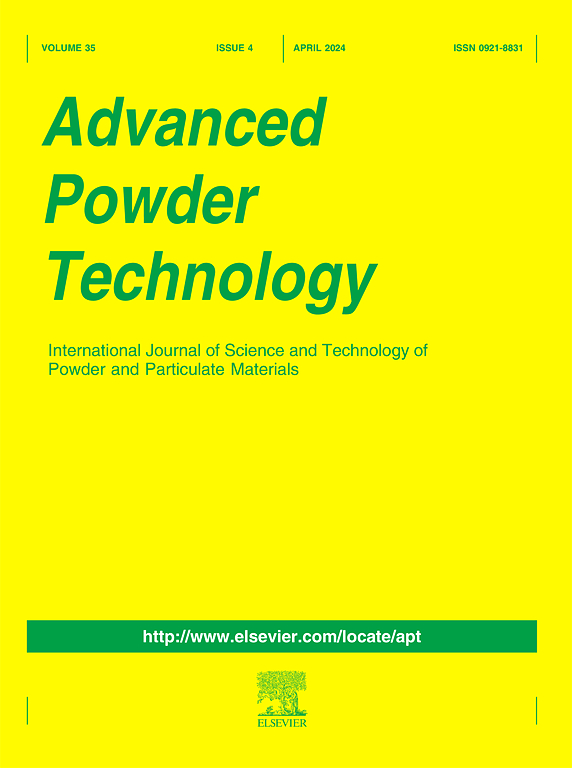CFD-DEM study on circulation pattern and particle suspension dynamics in PBT solid–liquid stirred tank
IF 4.2
2区 工程技术
Q2 ENGINEERING, CHEMICAL
引用次数: 0
Abstract
The stirred tank is widely used in industrial processes for efficient material mixing. In this work, a multi-scale numerical model suitable for dense particle flow is established based on the CFD-DEM approach. After verifying the reliability of the model by comparing with experiments, the solid–liquid two-phase behaviors in a single-layer unbaffled pitched blade turbine (PBT) stirred tank under transitional flow regime are investigated at different stirring speeds. The chain effect of stirring speed- discharge stream-suspension dynamics and the hindering mechanism of isolated mixing zone in solid–liquid system are revealed. Results show that the discharge stream caused by the pitched blades, which is directly affected by the stirring speed dominates the formation of two main circulation structures and the isolated mixing regions (IMRs). Notably, when the stirring speed exceeds a threshold, which lies between 350 rpm and 450 rpm, the enhancement of suspension is significantly diminished. To elucidate the underlying mechanism responsible for this phenomenon in the transitional flow regime, this study employs a multi-scale and multi-physics analysis. The outcomes of this study present insights into solid–liquid flow dynamics and provide a theoretical basis for optimizing stirred tank performance.

PBT固液搅拌槽内循环模式及颗粒悬浮动力学的CFD-DEM研究
搅拌槽广泛应用于工业生产过程中,以实现物料的高效混合。本文基于CFD-DEM方法,建立了适合于致密颗粒流的多尺度数值模型。在与实验对比验证模型可靠性的基础上,研究了过渡流型下单层无挡板斜桨涡轮(PBT)搅拌槽在不同搅拌速度下的固液两相行为。揭示了搅拌速度-出料流-悬浮动力学的连锁效应和固液体系中隔离混合区的阻碍机理。结果表明,桨叶倾斜引起的流量流主导了两种主循环结构和孤立混合区(IMRs)的形成,而桨叶倾斜直接受搅拌速度的影响。值得注意的是,当搅拌速度超过阈值时,即350 ~ 450 rpm之间,悬浮的增强明显减弱。为了阐明在过渡流态中造成这种现象的潜在机制,本研究采用了多尺度和多物理场分析。本研究结果提供了对固液流动动力学的见解,并为优化搅拌槽性能提供了理论基础。
本文章由计算机程序翻译,如有差异,请以英文原文为准。
求助全文
约1分钟内获得全文
求助全文
来源期刊

Advanced Powder Technology
工程技术-工程:化工
CiteScore
9.50
自引率
7.70%
发文量
424
审稿时长
55 days
期刊介绍:
The aim of Advanced Powder Technology is to meet the demand for an international journal that integrates all aspects of science and technology research on powder and particulate materials. The journal fulfills this purpose by publishing original research papers, rapid communications, reviews, and translated articles by prominent researchers worldwide.
The editorial work of Advanced Powder Technology, which was founded as the International Journal of the Society of Powder Technology, Japan, is now shared by distinguished board members, who operate in a unique framework designed to respond to the increasing global demand for articles on not only powder and particles, but also on various materials produced from them.
Advanced Powder Technology covers various areas, but a discussion of powder and particles is required in articles. Topics include: Production of powder and particulate materials in gases and liquids(nanoparticles, fine ceramics, pharmaceuticals, novel functional materials, etc.); Aerosol and colloidal processing; Powder and particle characterization; Dynamics and phenomena; Calculation and simulation (CFD, DEM, Monte Carlo method, population balance, etc.); Measurement and control of powder processes; Particle modification; Comminution; Powder handling and operations (storage, transport, granulation, separation, fluidization, etc.)
 求助内容:
求助内容: 应助结果提醒方式:
应助结果提醒方式:


